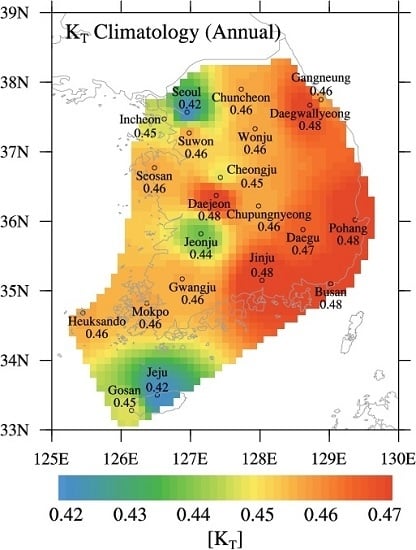Spatio-Temporal Characteristics in the Clearness Index Derived from Global Solar Radiation Observations in Korea
Abstract
:1. Introduction
2. Data and Methodology
2.1. Instruments and Data
2.2. Quality Assessment of Sample Data
2.3. Clearness Index
3. Results and Discussion
3.1. Temporal Variations
3.2. Spatial Distributions
3.3. Long-Term Trends
3.4. Contributions of CA, RH, and AOD to KT Variations
4. Summary and Conclusions
Acknowledgments
Author Contributions
Conflicts of Interest
References
- Che, H.; Shi, G.; Zhang, X.; Arimoto, R.; Zhao, J.; Xu, L.; Wang, B.; Chen, Z. Analysis of 40 years of solar radiation data from China, 1961–2000. Geophys. Res. Lett. 2005, 32. [Google Scholar] [CrossRef]
- Okogbue, E.; Adedokun, J.; Holmgren, B. Hourly and daily clearness index and diffuse fraction at a tropical station, Ile-Ife, Nigeria. Int. J. Climatol. 2009, 29, 1035–1047. [Google Scholar] [CrossRef]
- Bano, T.; Singh, S.; Gupta, N.; John, T. Solar global ultraviolet and broadband global radiant fluxes and their relationships with aerosol optical depth at New Delhi. Int. J. Climatol. 2013, 33, 1551–1562. [Google Scholar] [CrossRef]
- Liu, B.Y.; Jordan, R.C. The interrelationship and characteristic distribution of direct, diffuse and total solar radiation. Sol. Energy 1960, 4, 1–19. [Google Scholar] [CrossRef]
- Iqbal, M. An Introduction to Solar Radiation; Academic Press: San Diego, CA, USA, 1983; p. 390. [Google Scholar]
- Ideriah, F.; Suleman, S. Sky conditions at Ibadan during 1975–1980. Sol. Energy 1989, 43, 325–330. [Google Scholar] [CrossRef]
- Elhadidy, M.; Abdel-Nabi, D.; Kruss, P. Ultraviolet solar radiation at Dhahran, Saudi Arabia. Sol. Energy 1990, 44, 315–319. [Google Scholar] [CrossRef]
- Udo, S. Sky conditions at Ilorin as characterized by clearness index and relative sunshine. Sol. Energy 2000, 69, 45–53. [Google Scholar] [CrossRef]
- Ogunjobi, K.; Kim, Y.; Adedokun, J.; Ryu, S.; Kim, J. Analysis of sky condition using solar radiation data at Kwangju and Seoul, South Korea and Ile-Ife, Nigeria. Theor. Appl. Climatol. 2002, 72, 265–272. [Google Scholar] [CrossRef]
- Foyo-Moreno, I.; Vida, J.; Alados-Arboledas, L. A simple all weather model to estimate ultraviolet solar radiation (290–385 nm). J. Appl. Meteorol. 1999, 38, 1020–1026. [Google Scholar] [CrossRef]
- Cañada, J.; Pedrós, G.; López, A.; Boscá, J. Influences of the clearness index for the whole spectrum and of the relative optical air mass on UV solar irradiance for two locations in the Mediterranean area, Valencia and Cordoba. J. Geophys. Res. 2000, 105, 4759–4766. [Google Scholar] [CrossRef]
- Adam, M. Atmospheric modulations of the ratio of UVB to broadband solar radiation: Effect of ozone, water vapour, and aerosols at Qena, Egypt. Int. J. Climatol. 2014, 34, 2477–2488. [Google Scholar] [CrossRef]
- Adam, M.E.-N. Determination of daily total ultraviolet-B in a subtropical region (Upper Egypt): An empirical approach. Atmos. Res. 2015, 153, 1–9. [Google Scholar] [CrossRef]
- Wang, L.; Gong, W.; Lin, A.; Hu, B. Measurements and cloudiness influence on UV radiation in Central China. Int. J. Climatol. 2014, 34, 3417–3425. [Google Scholar] [CrossRef]
- Wang, L.; Gong, W.; Luo, M.; Wang, W.; Hu, B.; Zhang, M. Comparison of different UV models for cloud effect study. Energy 2015, 80, 695–705. [Google Scholar] [CrossRef]
- Alados-Arboledas, L.; Alados, I.; Foyo-Moreno, I.; Olmo, F.; Alcántara, A. The influence of clouds on surface UV erythemal irradiance. Atmos. Res. 2003, 66, 273–290. [Google Scholar] [CrossRef]
- Foyo-Moreno, I.; Alados, I.; Alados-Arboledas, L. Adaptation of an empirical model for erythemal ultraviolet irradiance. Ann. Geophys. 2007, 25, 1499–1508. [Google Scholar] [CrossRef]
- Antón, M.; Serrano, A.; Cancillo, M.; García, J. Relationship between erythemal irradiance and total solar irradiance in South-Western Spain. J. Geophys. Res. 2008, 113. [Google Scholar] [CrossRef]
- Antón, M.; Serrano, A.; Cancillo, M.; García, J. An empirical model to estimate ultraviolet erythemal transmissivity. Ann. Geophys. 2009, 27, 1387–1398. [Google Scholar] [CrossRef]
- Udo, S.; Aro, T. Global PAR related to global solar radiation for central Nigeria. Agric. For. Meteorol. 1999, 97, 21–31. [Google Scholar] [CrossRef]
- Wang, L.; Gong, W.; Ma, Y.; Hu, B.; Zhang, M. Photosynthetically active radiation and its relationship with global solar radiation in Central China. Int. J. Biometeorol. 2014, 58, 1265–1277. [Google Scholar] [CrossRef] [PubMed]
- Wang, L.; Gong, W.; Li, C.; Lin, A.; Hu, B.; Ma, Y. Measurement and estimation of photosynthetically active radiation from 1961 to 2011 in Central China. Appl. Energy 2013, 111, 1010–1017. [Google Scholar] [CrossRef]
- Escobedo, J.F.; Gomes, E.N.; Oliveira, A.P.; Soares, J. Modeling hourly and daily fractions of UV, PAR and NIR to global solar radiation under various sky conditions at Botucatu, Brazil. Appl. Energy 2009, 86, 299–309. [Google Scholar] [CrossRef]
- Wang, L.; Gong, W.; Li, J.; Ma, Y.; Hu, B. Empirical studies of cloud effects on ultraviolet radiation in Central China. Int. J. Climatol. 2014, 34, 2218–2228. [Google Scholar] [CrossRef]
- Adam, M.E.-N.; Ahmed, E.A. Comparative analysis of cloud effects on ultraviolet-B and broadband solar radiation: Dependence on cloud amount and solar zenith angle. Atmos. Res. 2016, 168, 149–157. [Google Scholar] [CrossRef]
- Ogunjobi, K.; Kim, Y. Ultraviolet (0.280–0.400 μm) and broadband solar hourly radiation at Kwangju, South Korea: Analysis of their correlation with aerosol optical depth and clearness index. Atmos. Res. 2004, 71, 193–214. [Google Scholar] [CrossRef]
- Adam, M.E.-N. Sensitivity analysis of aerosols’ effect in UVB transmission to solar zenith angle at subtropical location (Qena, Egypt). Atmos. Environ. 2013, 71, 311–318. [Google Scholar] [CrossRef]
- Dervishi, S.; Mahdavi, A. Computing diffuse fraction of global horizontal solar radiation: A model comparison. Sol. Energy 2012, 86, 1796–1802. [Google Scholar] [CrossRef]
- Duzen, H.; Aydin, H. Sunshine-based estimation of global solar radiation on horizontal surface at Lake Van region (Turkey). Energy Convers. Manag. 2012, 58, 35–46. [Google Scholar] [CrossRef]
- Cho, H.K.; Kim, J.; Jung, Y.; Lee, Y.G.; Lee, B.Y. Recent changes in downward longwave radiation at King Sejong Station, Antarctica. J. Clim. 2008, 21, 5764–5776. [Google Scholar] [CrossRef]
- Geiger, M.; Diabaté, L.; Ménard, L.; Wald, L. A web service for controlling the quality of measurements of global solar irradiation. Sol. Energy 2002, 73, 475–480. [Google Scholar] [CrossRef]
- Estupiñán, J.G.; Raman, S.; Crescenti, G.H.; Streicher, J.J.; Barnard, W.F. Effects of clouds and haze on UV-B radiation. J. Geophys. Res. 1996, 101, 16807–16816. [Google Scholar] [CrossRef]
- Spitters, C.; Toussaint, H.; Goudriaan, J. Separating the diffuse and direct component of global radiation and its implications for modeling canopy photosynthesis Part I. Components of incoming radiation. Agric. For. Meteorol. 1986, 38, 217–229. [Google Scholar] [CrossRef]
- Jacovides, C.; Tymvios, F.; Assimakopoulos, V.; Kaltsounides, N. The dependence of global and diffuse PAR radiation components on sky conditions at Athens, Greece. Agric. For. Meteorol. 2007, 143, 277–287. [Google Scholar] [CrossRef]
- Duffie, J.A.; Beckman, W.A. Solar Engineering of Thermal Processes, 4th ed.; John Wiley & Sons Inc.: Hoboken, NJ, USA, 1980. [Google Scholar]
- Cooper, P. The absorption of radiation in solar stills. Sol. Energy 1969, 12, 333–346. [Google Scholar] [CrossRef]
- Erbs, D.; Klein, S.; Duffie, J. Estimation of the diffuse radiation fraction for hourly, daily and monthly-average global radiation. Sol. Energy 1982, 28, 293–302. [Google Scholar] [CrossRef]
- Jacovides, C.; Hadjioannou, L.; Pashiardis, S.; Stefanou, L. On the diffuse fraction of daily and monthly global radiation for the island of Cyprus. Sol. Energy 1996, 56, 565–572. [Google Scholar] [CrossRef]
- Jo, D.-K.; Kang, Y.-H. A study on the analysis of global dimming appearances using the solar radiation measurement in Korean major cities (focused on atmospheric clearness analysis). J. Korean Sol. Energy Soc. 2007, 27, 45–52. [Google Scholar]
- Igawa, N.; Koga, Y.; Matsuzawa, T.; Nakamura, H. Models of sky radiance distribution and sky luminance distribution. Sol. Energy 2004, 77, 137–157. [Google Scholar] [CrossRef]
- Wang, L.; Gong, W.; Ma, Y.; Hu, B.; Wang, W.; Zhang, M. Analysis of ultraviolet radiation in Central China from observation and estimation. Energy 2013, 59, 764–774. [Google Scholar] [CrossRef]
- Ohmura, A.; Lang, H. Secular variation of global radiation in Europe. In Proceedings of the 1989 International Radiation Symposium, Lille, France, 18–24 August 1989; pp. 298–301.
- Liepert, B. Solar radiation in Germany: Observed trends and their causes. In Proceedings of the 1994 A & WMA International Specialty Conference on Climate Change, Phoenix, AZ, USA, 5–8 April 1994; Air and Waste Management Association: Pittsburgh, PA, USA, 1994. [Google Scholar]
- Ohmura, A. Observed decadal variations in surface solar radiation and their causes. J. Geophys. Res. 2009, 114, D00D05. [Google Scholar] [CrossRef]
- Overall, J.E. Applied Multivariate Analysis; McGraw-Hill: New York, NY, USA, 1972. [Google Scholar]

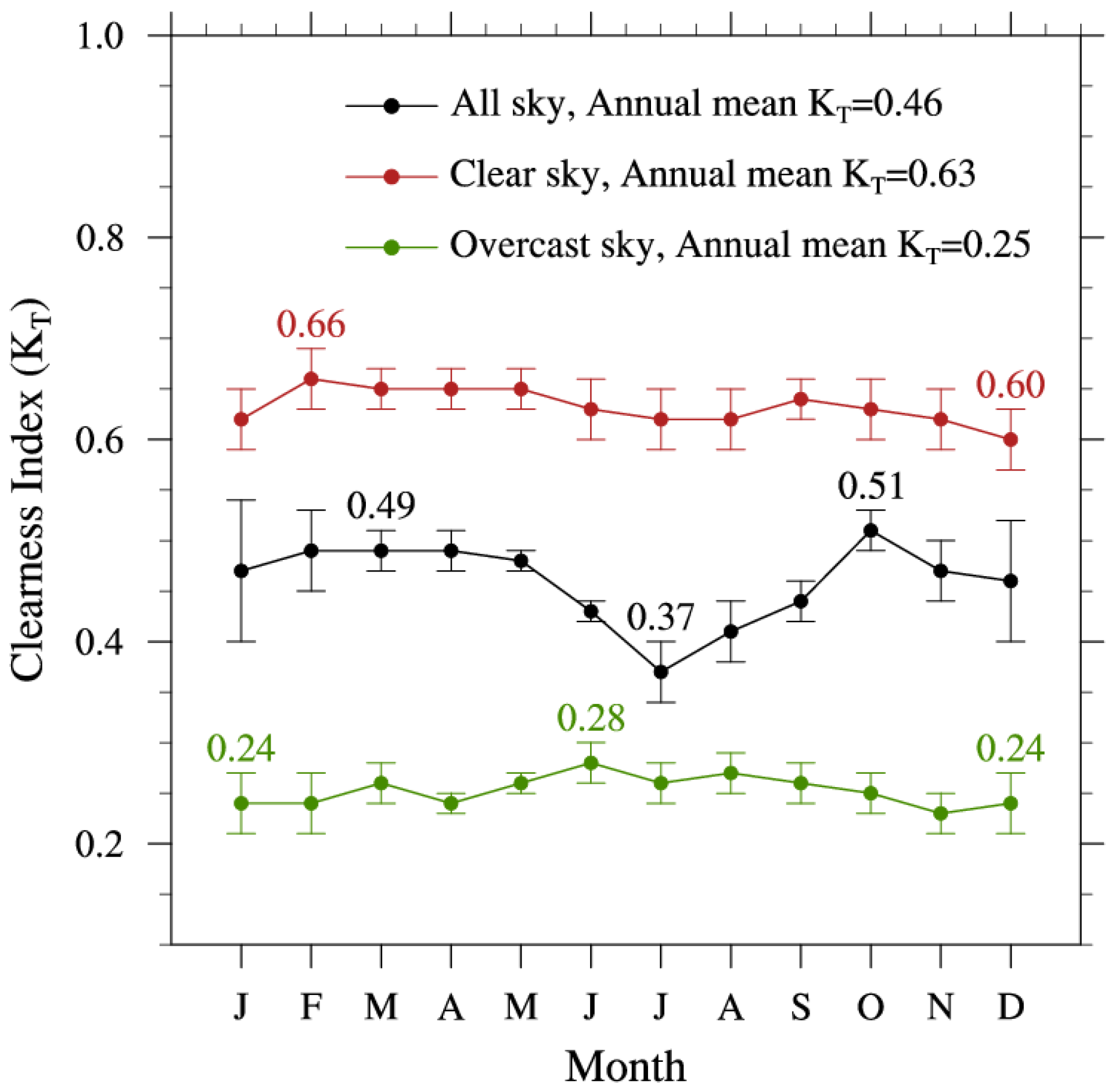
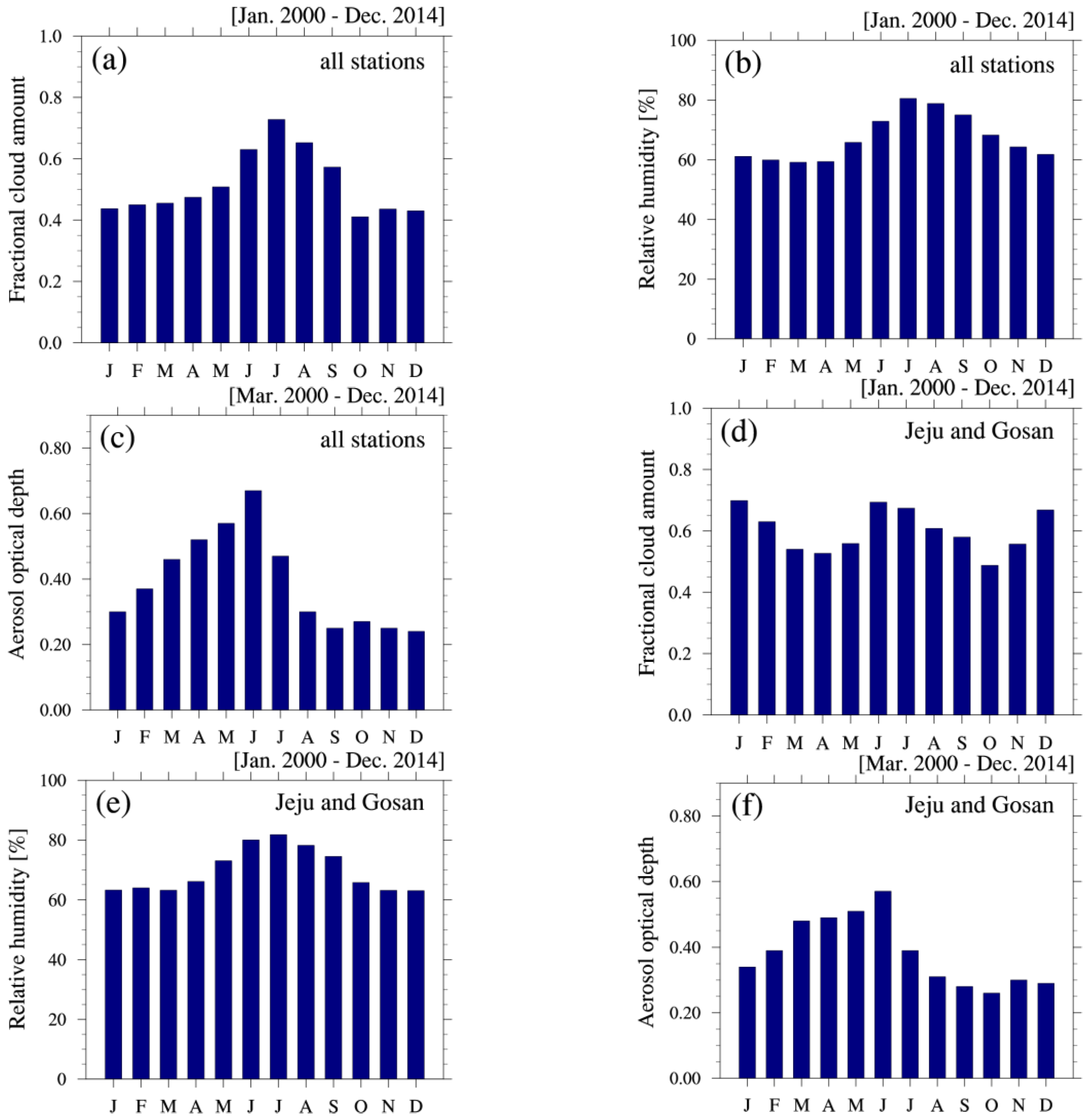
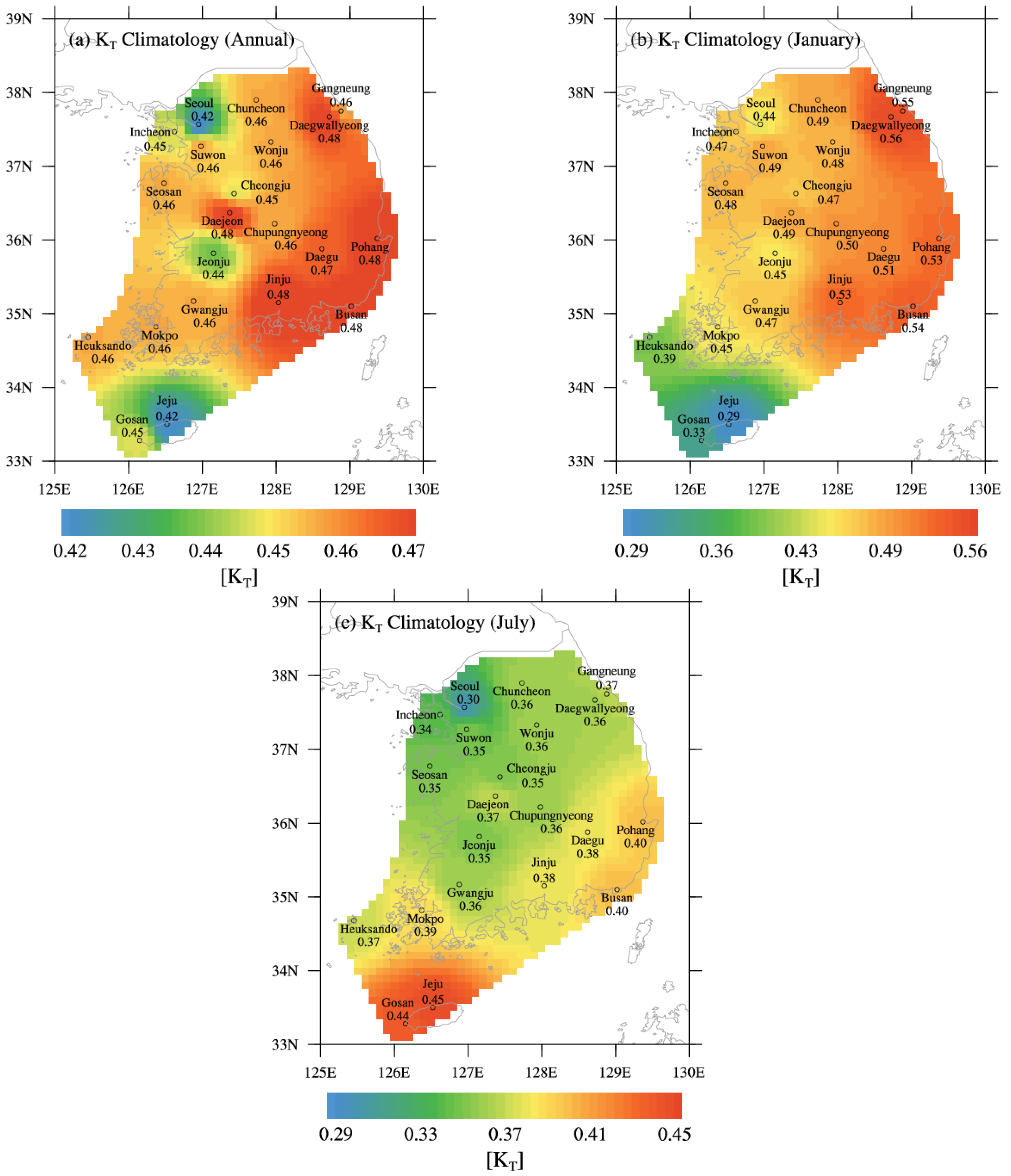
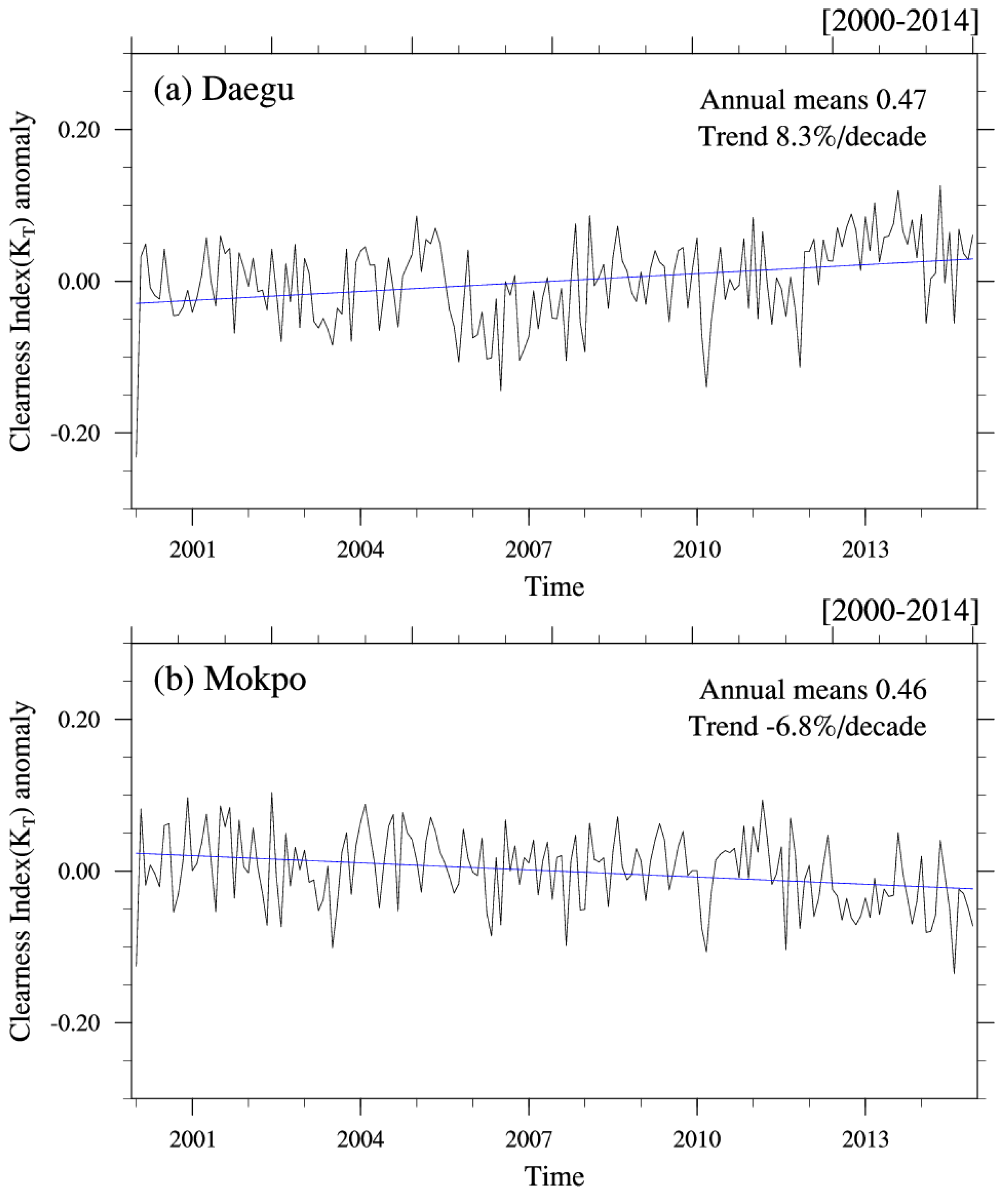
| Site | January | February | March | April | May | June | July | August | September | October | November | December | Annual |
|---|---|---|---|---|---|---|---|---|---|---|---|---|---|
| Daegwallyeong | 0.56 | 0.56 | 0.52 | 0.49 | 0.48 | 0.43 | 0.36 | 0.37 | 0.40 | 0.50 | 0.50 | 0.53 | 0.48 |
| Chuncheon | 0.49 | 0.51 | 0.49 | 0.47 | 0.48 | 0.46 | 0.36 | 0.41 | 0.45 | 0.49 | 0.45 | 0.46 | 0.46 |
| Gangneung | 0.55 | 0.48 | 0.47 | 0.48 | 0.47 | 0.42 | 0.37 | 0.38 | 0.44 | 0.50 | 0.49 | 0.51 | 0.46 |
| Seoul | 0.44 | 0.47 | 0.46 | 0.45 | 0.45 | 0.40 | 0.30 | 0.35 | 0.42 | 0.48 | 0.43 | 0.44 | 0.42 |
| Incheon | 0.47 | 0.50 | 0.49 | 0.47 | 0.46 | 0.42 | 0.34 | 0.39 | 0.44 | 0.49 | 0.45 | 0.45 | 0.45 |
| Wonju | 0.48 | 0.49 | 0.48 | 0.47 | 0.48 | 0.45 | 0.36 | 0.40 | 0.45 | 0.50 | 0.45 | 0.47 | 0.46 |
| Suwon | 0.49 | 0.51 | 0.50 | 0.48 | 0.48 | 0.44 | 0.35 | 0.40 | 0.44 | 0.51 | 0.46 | 0.47 | 0.46 |
| Seosan | 0.48 | 0.51 | 0.50 | 0.49 | 0.48 | 0.43 | 0.35 | 0.41 | 0.45 | 0.50 | 0.45 | 0.45 | 0.46 |
| Cheongju | 0.47 | 0.48 | 0.49 | 0.48 | 0.48 | 0.43 | 0.35 | 0.40 | 0.44 | 0.49 | 0.44 | 0.44 | 0.45 |
| Daejeon | 0.49 | 0.52 | 0.51 | 0.51 | 0.51 | 0.45 | 0.37 | 0.42 | 0.46 | 0.53 | 0.48 | 0.47 | 0.48 |
| Chupungnyeong | 0.50 | 0.50 | 0.50 | 0.49 | 0.47 | 0.42 | 0.36 | 0.38 | 0.42 | 0.50 | 0.48 | 0.48 | 0.46 |
| Pohang | 0.53 | 0.51 | 0.50 | 0.50 | 0.48 | 0.44 | 0.40 | 0.40 | 0.41 | 0.48 | 0.52 | 0.54 | 0.48 |
| Daegu | 0.51 | 0.51 | 0.51 | 0.50 | 0.49 | 0.43 | 0.38 | 0.39 | 0.43 | 0.50 | 0.49 | 0.51 | 0.47 |
| Jeonju | 0.45 | 0.46 | 0.48 | 0.48 | 0.47 | 0.42 | 0.35 | 0.39 | 0.44 | 0.50 | 0.45 | 0.43 | 0.44 |
| Gwangju | 0.47 | 0.50 | 0.51 | 0.50 | 0.49 | 0.41 | 0.36 | 0.40 | 0.45 | 0.53 | 0.49 | 0.46 | 0.46 |
| Busan | 0.54 | 0.52 | 0.50 | 0.50 | 0.48 | 0.43 | 0.40 | 0.43 | 0.44 | 0.50 | 0.52 | 0.53 | 0.48 |
| Mokpo | 0.45 | 0.48 | 0.50 | 0.50 | 0.48 | 0.42 | 0.39 | 0.44 | 0.47 | 0.53 | 0.48 | 0.42 | 0.46 |
| Heuksando | 0.39 | 0.46 | 0.52 | 0.52 | 0.49 | 0.43 | 0.37 | 0.46 | 0.49 | 0.54 | 0.47 | 0.39 | 0.46 |
| Jeju | 0.29 | 0.38 | 0.45 | 0.49 | 0.48 | 0.42 | 0.45 | 0.45 | 0.44 | 0.48 | 0.40 | 0.30 | 0.42 |
| Gosan | 0.33 | 0.44 | 0.49 | 0.51 | 0.49 | 0.41 | 0.44 | 0.49 | 0.50 | 0.53 | 0.43 | 0.33 | 0.45 |
| Jinju | 0.53 | 0.52 | 0.52 | 0.50 | 0.48 | 0.41 | 0.38 | 0.41 | 0.45 | 0.54 | 0.52 | 0.54 | 0.48 |
| AVERAGE | 0.47 | 0.49 | 0.49 | 0.49 | 0.48 | 0.43 | 0.37 | 0.41 | 0.44 | 0.51 | 0.47 | 0.46 | 0.46 |
| Increasing KT Trend (>+4.0%/Decade) | ||||
| Site | KT | CA | RH | AOD |
| Seoul | 4.08 | −0.18 | −3.21 | −7.43 |
| Daegwallyeong | 4.26 | 4.35 | −1.30 | −4.32 |
| Jinju | 4.55 | 0.04 | 0.88 | −13.79 |
| Daejeon | 5.57 | −1.22 | 4.03 | −9.10 |
| Daegu | 8.30 | 0.94 | −3.83 | −13.79 |
| Decreasing KT Trend (<−4.0%/Decade) | ||||
| Site | KT | CA | RH | AOD |
| Cheongju | −4.54 | −2.58 | −0.11 | −9.10 |
| Seosan | −6.25 | −6.20 | 5.35 | −13.41 |
| Mokpo | −6.76 | 3.53 | 10.31 | −11.22 |
| Gangneung * | −10.49 | 8.82 | −7.87 | −4.32 |
| Site | R2 | Partial Correlation Coefficients (γ1n) | Individual Contribution (%) | ||||
|---|---|---|---|---|---|---|---|
| γ12 (CA) | γ13 (RH) | γ14 (AOD) | CA | RH | AOD | ||
| Daegwallyeong | 0.59 | −0.75 | −0.56 | −0.31 | 47.1 | 9.0 | 2.8 |
| Chuncheon | 0.57 | −0.71 | −0.48 | −0.45 | 36.6 | 11.1 | 9.7 |
| Gangneung | 0.64 | −0.80 | −0.55 | −0.36 | 57.3 | 3.7 | 3.4 |
| Seoul | 0.60 | −0.71 | −0.58 | −0.41 | 36.4 | 16.5 | 6.8 |
| Incheon | 0.47 | −0.66 | −0.43 | −0.39 | 35.3 | 6.2 | 5.8 |
| Wonju | 0.58 | −0.71 | −0.46 | −0.43 | 39.3 | 10.1 | 8.2 |
| Suwon | 0.54 | −0.69 | −0.50 | −0.37 | 36.6 | 12.7 | 4.9 |
| Seosan | 0.60 | −0.69 | −0.52 | −0.43 | 35.1 | 15.8 | 8.6 |
| Cheongju | 0.51 | −0.66 | −0.49 | −0.36 | 31.7 | 13.3 | 6.4 |
| Daejeon | 0.59 | −0.72 | −0.43 | −0.42 | 41.5 | 9.2 | 8.6 |
| Chupungnyeong | 0.59 | −0.73 | −0.48 | −0.39 | 41.5 | 10.2 | 7.6 |
| Pohang | 0.56 | −0.72 | −0.52 | −0.39 | 42.3 | 7.6 | 6.0 |
| Daegu | 0.53 | −0.67 | −0.52 | −0.44 | 30.3 | 13.7 | 9.4 |
| Jeonju | 0.59 | −0.71 | −0.48 | −0.36 | 39.4 | 13.1 | 6.4 |
| Gwangju | 0.59 | −0.71 | −0.53 | −0.34 | 39.4 | 14.3 | 5.2 |
| Busan | 0.55 | −0.72 | −0.45 | −0.41 | 44.4 | 4.4 | 6.2 |
| Mokpo | 0.54 | −0.69 | −0.41 | −0.31 | 41.6 | 8.5 | 4.3 |
| Heuksando | 0.61 | −0.76 | −0.28 | −0.35 | 54.8 | 0.4 | 5.6 |
| Jeju | 0.63 | −0.79 | −0.26 | −0.19 | 63.3 | −1.0 | 0.7 |
| Gosan | 0.55 | −0.73 | −0.13 | −0.26 | 53.9 | −1.2 | 2.4 |
| Jinju | 0.55 | −0.69 | −0.41 | −0.49 | 36.9 | 6.5 | 12.1 |
| Average | 0.57 | −0.72 | −0.45 | −0.37 | 42.1 | 8.8 | 6.2 |
© 2016 by the authors; licensee MDPI, Basel, Switzerland. This article is an open access article distributed under the terms and conditions of the Creative Commons by Attribution (CC-BY) license (http://creativecommons.org/licenses/by/4.0/).
Share and Cite
Jung, Y.; Lee, H.; Kim, J.; Cho, Y.; Kim, J.; Lee, Y.G. Spatio-Temporal Characteristics in the Clearness Index Derived from Global Solar Radiation Observations in Korea. Atmosphere 2016, 7, 55. https://doi.org/10.3390/atmos7040055
Jung Y, Lee H, Kim J, Cho Y, Kim J, Lee YG. Spatio-Temporal Characteristics in the Clearness Index Derived from Global Solar Radiation Observations in Korea. Atmosphere. 2016; 7(4):55. https://doi.org/10.3390/atmos7040055
Chicago/Turabian StyleJung, Yeonjin, Hana Lee, Jaemin Kim, Youngbum Cho, Jhoon Kim, and Yun Gon Lee. 2016. "Spatio-Temporal Characteristics in the Clearness Index Derived from Global Solar Radiation Observations in Korea" Atmosphere 7, no. 4: 55. https://doi.org/10.3390/atmos7040055





